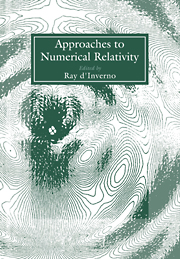Book contents
- Frontmatter
- Contents
- Contributors
- Introduction
- Preface
- PART A THEORETICAL APPROACHES
- Numerical relativity on a transputer array
- Some aspects of the characteristic initial value problem in numerical relativity
- The characteristic initial value problem in general relativity
- Algebraic approach to the characteristic initial value problem in general relativity
- On hyperboloidal hypersurfaces
- The initial value problem on null cones
- Introduction to dual-null dynamics
- On colliding plane wave space-times
- Boundary conditions for the momentum constraint
- On the choice of matter model in general relativity
- A mathematical approach to numerical relativity
- Making sense of the effects of rotation in general relativity
- Stability of charged boson stars and catastrophe theory
- PART B PRACTICAL APPROACHES
- PANEL DISCUSSION
A mathematical approach to numerical relativity
Published online by Cambridge University Press: 15 December 2009
- Frontmatter
- Contents
- Contributors
- Introduction
- Preface
- PART A THEORETICAL APPROACHES
- Numerical relativity on a transputer array
- Some aspects of the characteristic initial value problem in numerical relativity
- The characteristic initial value problem in general relativity
- Algebraic approach to the characteristic initial value problem in general relativity
- On hyperboloidal hypersurfaces
- The initial value problem on null cones
- Introduction to dual-null dynamics
- On colliding plane wave space-times
- Boundary conditions for the momentum constraint
- On the choice of matter model in general relativity
- A mathematical approach to numerical relativity
- Making sense of the effects of rotation in general relativity
- Stability of charged boson stars and catastrophe theory
- PART B PRACTICAL APPROACHES
- PANEL DISCUSSION
Summary
Abstract. This article contains some proposals for the construction of an algorithm for the evolution of initial data in general relativity which will apply to generic initial values. One of the main issues is to allow a dynamic refinement of the discretisation which will be local and vary according to local values of the initial data. I outline some of the main problems which will have to be addressed in any implementation of the general scheme. There are also some suggestions for a construction of a smooth solution of the Einstein equations which is near to the discrete evolution.
INTRODUCTION
At the present time, computer codes for general relativity are written specifically for particular problems such as stellar collapse or coalescing binary systems. In the longer run relativists are interested in using the computer as a mathematical tool to investigate the properties of solutions which seem inaccessible by analytic means, or to formulate hypotheses which may then be attacked analytically. This requires the construction of an algorithm which applies to generic initial data and which also has a sufficiently solid framework which allows analytic investigation of the error of the approximation.
The approach I would like to suggest is based on triangulations. One of the problems of numerical relativity is that the degree of discretisation that is required to approximate given data well is dependent on that data. However one cannot predict — in advance — how this will evolve as the data evolves with time.
- Type
- Chapter
- Information
- Approaches to Numerical Relativity , pp. 103 - 113Publisher: Cambridge University PressPrint publication year: 1992
- 1
- Cited by



